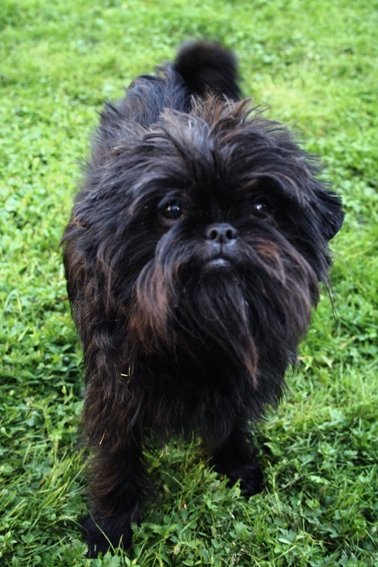The Affenpinscher, also called the Affen, has a shaggy wire-type coat and is on the smaller side. Unlike most breeds, the hair on the face of the Affenpinscher is longer than the hair on the rest of the body, resulting in a unique and distinctive look. The undercoat is slightly curly, giving the coat a bouncy appearance.
The Affen generally stands between 10 and 15 inches at the shoulder and weighs seven or eight pounds. Despite its small size, the Affen is not a delicate dog. It is a working dog and has a stocky body with a deep chest. The ears and tail are traditionally docked, but this is slowly becoming less common as various countries ban docking entirely. The coat is usually black or dark gray, though other acceptable colors include silver, red, light gray, or black and tan.
As a terrier, the Affenpinscher can be stubborn, bold, inquisitive, and mischievous. They are excellent with other pets if they are raised with them but often develop dominant tendencies. For this reason, owners of Affens should take care to give the dog limitations and boundaries early in life. These dogs are not recommended for young children, though older children usually enjoy these little dogs. They shed very little and so are suitable for many people who can't handle a shedding breed.
These dogs like to bark and will climb fences and occasionally trees. They are quite intelligent but they do become bored easily, so try to keep your Affenpinscher engaged and they'll respond to training better. Many are difficult to housebreak, but a little persistence usually does the trick.
Some Affenpinschers are prone to fractures. They may also experience slipped stifle, open fontanel, respiratory problems, and patent ductus arteriosus (PDA). These dogs do fine without a yard and so are suitable for apartments provided they get two or three good walks a day. Affens are sensitive to temperature extremes and should not be left in either warm or cold weather for very long. Additionally, hot weather can damage the coat.
It's difficult to say where the Affenpinscher originally came from. However, they seem to have emerged in Germany, though these dogs were significantly lager than today's Affenpinscher. The larger dog worked on farms as a ratter and watchdog. In the 18th century, a concerted effort to miniaturize this breed began, initiating the first selective breeding the Affen had ever known. The drive to hunt and protect never lessened, however. They might be a companion dog today, but they will still hunt down mice that sneak into the house and alert their owners to intruders.
The Affenpinshcer is the perfect companion for anyone with a little patience and a willingness to work with this demanding little dog. It can also be registered with most associations around the world.

No comments:
Post a Comment